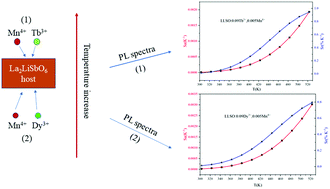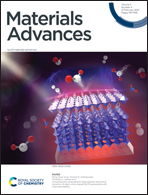Dual-emissive Ln3+/Mn4+ Co-doped double perovskite phosphor via site-beneficial occupation†
Abstract
The non-contact temperature detectors based on fluorescence intensity ratio (FIR) technology have been widely studied. In the past few decades, researchers have been working on optical temperature measurement via FIR technology based on the two thermally-coupled energy levels (TCLs) of rare-earth ions. However, the FIR method based on TCLs has inherent limitations, which hinder further improvement of relative sensitivity (Sr). In order to further improve the temperature measurement performance, we have designed a dual-activator luminescence system of La2LiSbO6 (LLSO) perovskite co-doped with rare-earth (Tb3+, Dy3+) ions and transition metal (Mn4+) ions according to the site-beneficial occupation principle. LLSO provides suitable occupation sites for Tb3+/Dy3+ ions and Mn4+ ions. The experimental results show that these doped ions can enter the matrix successfully and emit luminescence simultaneously. The emission peaks of Tb3+/Dy3+ ions and Mn4+ ions are well separated, which provides a good signal identification ability for temperature detection. In addition, Tb3+/Dy3+ ions and Mn4+ ions have different sensitivities to the environment due to their different external electronic configurations, which leads to different thermal quenching responses of their fluorescence emission intensity. The decline rate of Mn4+ ions is much faster than that of Tb3+/Dy3+ ions, which is very useful for temperature measurement based on FIR technology. Therefore, Tb3+/Dy3+ ions can be used as reference signals, whereas Mn4+ ions are suitable detection signals. We have investigated the temperature detection performance at different luminescent positions of luminescent ions. The results show that the fluorescence intensity ratio between Tb3+/Dy3+ ions and Mn4+ ions in the materials exhibits excellent temperature sensing performance in the temperature range of 303–523 K. The maximum relative sensitivity and absolute sensitivity of Tb3+ and Mn4+ co-doped LLSO phosphors are 0.946% K−1 and 0.00193 K−1, respectively; the maximum relative sensitivity and absolute sensitivity of Dy3+ and Mn4+ co-doped LLSO phosphors are 0.796% K−1 and 0.00832 K−1, respectively, which are much higher than those of some optical thermometric materials reported previously. The self-reference optical temperature measurement method based on double luminescent centers proposed in this paper can provide a new viewpoint for the development of high-performance thermometers.

- This article is part of the themed collection: Perovskites


 Please wait while we load your content...
Please wait while we load your content...